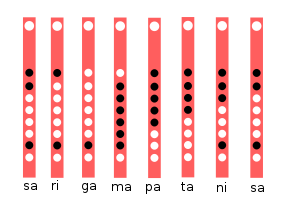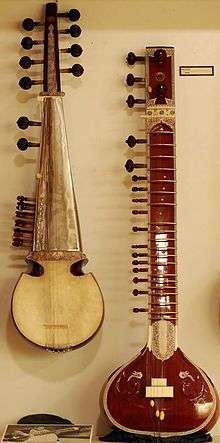Venu
The venu[1] (Sanskrit: वेणु; veṇu) is one of the ancient transverse flutes of Indian classical music.[2] It is an aerophone typically made from bamboo, that is a side blown wind instrument. It continues to be in use in the South Indian Carnatic music tradition.[3] In Northern Indian music, a similar flute is called bansuri.[4] In the South, it is also called by various other names such as pullankuzhal (புல்லாங்குழல்) in Tamil, പുല്ലാങ്കുഴല് in Malayalam, and ಕೊಳಲು (koḷalu) in Kannada. It is known as pillana grōvi (పిల్లన గ్రోవి) or Vēṇuvu (వేణువు) in Telugu (Andhra Pradesh). It is also called as Carnatic Flute.
 | |
| Other names | Muraḷi, Vēṇuvu, pillana grōvi, kūḷalu, pullankuzhal |
|---|---|
| Classification | Indian Woodwind Instrument |
| Playing range | |
| More than 2.5 Octaves (8-hole bamboo flute) | |
| Related instruments | |
| Bansuri | |
| Musicians | |
| List of Indian Flautists | |
| More articles or information | |
| Palladam Sanjiva Rao, H. Ramachandra Shastry, T. R. Mahalingam, T. Viswanathan etc.. | |
The venu is discussed as an important musical instrument in the Natya Shastra, the classic Hindu text on music and performance arts.[5] The ancient Sanskrit texts of India describe other side blown flutes such as the murali and vamsika, but sometimes these terms are used interchangeably. A venu has six holes, is about the thickness of a thumb, and twelve fingers long. A longer murali has four holes and two hands longs. The vamsika has eight holes, between twelve and seventeen fingers long.[6]
A venu is a part of the iconography of Hindu god Krishna.[2]
Construction and technique

One of the oldest musical instruments of India, the instrument is a key-less transverse flute made of bamboo. The fingers of both hands are used to close and open the holes. It has a blowing hole near one end, and eight closely placed finger holes. The instrument comes in various sizes. The venu is also a highly respected instrument and those who play it are expected to appreciate it, for it is considered a gift to be able to play it.
The venu is capable of producing two and half octaves with the help of over-blowing and cross fingering. The flute is like the human voice in that it is monophonous and also has a typical two and half octave sound reproduction. Sliding the fingers on and off the holes allows for production of variety of Gamakas, important in the performance of raga-based music.
History
The flute (Venu) finds great mention in Indian mythology and folklore having been listed as among the 3 original instruments meant for music along with the human sound and Veena (vaani-veena-venu).[7] However it is strange that there is no name mentioned for the typical flute that the Lord plays.
The venu is associated with the Hindu god Krishna, who is often depicted playing it. This kind of flute is mainly used in South India.The Lord Vishnu is portrayed as Sri Venugopala - playing the flute of Creation.
In the Hindustani style, it is known as Bansuri. In the Carnatic style, it is known as flute.
Flute sizes and scale construction
The flute scale usually marked on the blowing end cap. The flute scale denoted either in number 1 to 8 or in alphabets G to A. The size varies up to 12 sizes in length each providing the scale. The diameter of the flute also varies based the scale.
There are many custom sized flutes are also available. Some flute even goes beyond 1 meter length. There is no limit in the imagination of these kind of flute construction. Few examples are Double contrabass flute, Contrabass flute and Anahat Venu. These flute can go upto 12 feet[8].
Some experts uses an extra hole in the bottom of the flute, this construction is very rare.
Some holes may not equally spaced based on either curve of the bamboo or to facilitate the artist's finger comfort.
Even a PVC pipe can be used to construct a flute in a very simple way, simply using a common scissors.
Making the first sound
Anyone who can blow a bottle mouth and make a sound can learn flute. The transverse flute is blown at the blow hole side wise. The blown air cuts the edge of the blowing hole and the exit of the air and the distance it travels makes the sound.
The edge is sharpen angular inside the hole in such a way the air can be split easily. In case the bamboo is damaged then the flute will make noise while blowing.
Musical notes

full hole closing/opening
Playing including the next scale sa, which is eight notes (sa, re, ga, ma, pa, dha, ni, sa) is followed in the basics of carnatic flute learning lessons, Jumping between ga ma pa is called as middle play, it produces a sound like a breaking voice of human vocals, almost closer to the chest to head voice movement feeling.
This jumping requires practice that the flute should not fall from the hand grip and also none of the holes half closed unnecessarily. The blowing pressure needs to be changed carefully without distorting the sound. The artist should bring all 5 fingers to close 5 holes which could be little bit difficult while playing a fast song at beginning stage of learning.
Extreme thin strong blowing techniques allows the artist to even play few extra notes beyond the range the flute (some times leads to whistle sound).
Flipping/Angling the flute in the blow hole is also allows the artist to modify the flute sound slightly.
while blowing the air, the artist can choose either continuously blowing or non-continuously blowing or even use the tough/lips to vibrate the air to play the music.
While playing music, the artist is not limited to the 8 note. The artist can close three holes, four holes, five holes and play low notes also. which means using a 8 holed flute, the artist can play up to 15+ full finger closed/open notes.
Half finger closed musical notes
The artist can use the finger to close the hole half or quarter or three quarter to make different sounds[9], even though the sound does not falls in the standard keyboard but it is up to the imagination of the music artist to make those sounds.
This technique allows the artist to play almost 30+ notes in one flute. As a standard the black keys in a keyboard can be sounded in a flute with half finger closed on the corresponding hole.
Slow opening and slow closing the hole allows the music curves/pitching to move between one note to another note while continuously blowing, even two/three fingers can be slow closed and slow opened while continuously blowing. This sound curving technique produces Gamak from Carnatic music.
This technique allows the artist to play like a Song of male from the bird Asian koel. This can be related to hard pressing the Veena string to get the bending/pitching note or using a Pitch Wheel in a Electronic/MIDI keyboard.
Venu Players
Venu players of the past
- Palladam Sanjiva Rao (1882-1962), a disciple of Sharaba Shastri.
- H. Ramachandra Shastry (1906 - 1992), a disciple of Palladam Sanjiva Rao.
- T. R. Mahalingam (1926-1986), a child venuist prodigy who started playing the flute at the age of five years. He is most popularly known as "Mali" or sometimes "Flute Mali."
- T.A. Hariharan, Disciple of T.K. Radhakrishnan
- T.K.Radhakrishnan (1919-2003)
- Manda Balarama Sharma, Disciple of T.R.Mahalingam
- T. Viswanathan (1927-2002), grandson of Veena Dhanammal and brother of Balasaraswati
- Cochin Ranganathan
- B.N.Suresh, (1946-1990) disciple of T.R.Mahalingam
- Prapancham Sitaram (d.2014)
- N. Kesi (1918-2015)
- Dindigul S.P. Natarajan, Disciple of T.R.Mahalingam
- K.S. Narayanaswamy, (Flute) (d. 2003)
- N Ramani (1934-2015), disciple of T.R.Mahalingam
- A.V.Prakash (1941 - 2016)
- Sikkil Sisters - Kunjumani & Neela
Venu players of the present
- G.Raghuraman (b.1968)
- G. S. Rajan (b. 1962)
- K. Bhaskaran (b. 1961)
- B. Shankar Rao (b. 1922)
- B.M. Sundar Rao (b. 1937)
- T. S. Sankaran (1930 - 2015)
- K. S. Gopalakrishnan (b. 1929)
- Guruvayoor Srikishnan (1936 - 2019)
- Tiruchy L. Saravanan
- Ludwig Pesch
- Thiagarajan Ramani (b. 1962)
- Sikkil Mala Chandrasekar (b. 1963)
- Kudamaloor Janardanan (b.1969)
- Raman Kalyan
- Shashank Subramanyam (b.1979)
- Prasanth P Shenoi
- J.A.Jayanth
- J.B. Sruti Sagar
- Trivandrum R Sreekumar
- Visveshwar Nagarajan (b. 1996)
- chittor K pathanjali
- G.Sridhar ( b.1969 )
- V.Vasanth Kumar vairamanickam
See also
- Bansuri
- Carnatic Music
- Hindustani Music
- Bamboo musical instruments
- Wind instrument
References
- Sanskrit Dictionary-Venu.
- Lochtefeld 2002, p. 747.
- Bruno Nettl; Thomas Turino; Isabel Wong; et al. (2015). Excursions in World Music. Taylor & Francis. p. 691. ISBN 978-1-317-35029-3.
- Dalal 2014, p. 163.
- Rowell 2015, pp. 99–103.
- The Bhaktirasāmṛtasindhu of Rūpa Gosvāmin. Motilal Banarsidass. 2003. p. 217. ISBN 978-81-208-1861-3.
- Tarla Mehta (1995). Sanskrit Play Production in Ancient India. Motilal Banarsidass. pp. 149–150. ISBN 978-81-208-1057-0.
- Azharuddin Shaikh (2016). "World Record - longest and smallest flute playing performance in a concert, Anahat Venu (12 feet) and Chetanya Venu (1 Inch)".
- K.N. Shivakumar (2019). Carnatic Music - Sadhakams. Sangeet Bharati. pp. 14–20.
Bibliography
- Beck, Guy (1993). Sonic Theology: Hinduism and Sacred Sound. Columbia: University of South Carolina Press. ISBN 978-0-87249-855-6.CS1 maint: ref=harv (link)
- Caudhurī, Vimalakānta Rôya (2000). The Dictionary of Hindustani Classical Music. Motilal Banarsidass. ISBN 978-81-208-1708-1.CS1 maint: ref=harv (link)
- Dalal, Roshen (2014). Hinduism: An Alphabetical Guide. Penguin Books. ISBN 978-81-8475-277-9.CS1 maint: ref=harv (link)
- Daniélou, Alain (1949). Northern Indian Music, Volume 1. Theory & technique; Volume 2. The main rāgǎs. London: C. Johnson. OCLC 851080.
- Gautam, M.R. (1993). Evolution of Raga and Tala in Indian Music. Munshiram Manoharlal. ISBN 81-215-0442-2.CS1 maint: ref=harv (link)
- Kaufmann, Walter (1968). The Ragas of North India. Oxford & Indiana University Press. ISBN 978-0-253-34780-0. OCLC 11369.
- Lochtefeld, James G. (2002). The Illustrated Encyclopedia of Hinduism, 2 Volume Set. The Rosen Publishing Group. ISBN 978-0-8239-2287-1.CS1 maint: ref=harv (link)
- Martinez, José Luiz (2001). Semiosis in Hindustani Music. Motilal Banarsidass. ISBN 978-81-208-1801-9.CS1 maint: ref=harv (link)
- Nettl, Bruno; Ruth M. Stone; James Porter; Timothy Rice (1998), The Garland Encyclopedia of World Music: South Asia : the Indian subcontinent, Routledge, ISBN 978-0-8240-4946-1
- Randel, Don Michael (2003). The Harvard Dictionary of Music (fourth ed.). Cambridge, MA: Harvard University Press. ISBN 978-0-674-01163-2.CS1 maint: ref=harv (link)
- Rowell, Lewis (2015). Music and Musical Thought in Early India. University of Chicago Press. ISBN 978-0-226-73034-9.CS1 maint: ref=harv (link)
- P, Sambamoorthy (1982). The Flute. Indian music Publishing House.
- Sorrell, Neil; Narayan, Ram (1980). Indian Music in Performance: A Practical Introduction. Manchester University Press. ISBN 978-0-7190-0756-9.CS1 maint: ref=harv (link)
- Te Nijenhuis, Emmie (1974). Indian Music: History and Structure. BRILL Academic. ISBN 90-04-03978-3.CS1 maint: ref=harv (link)
- Wilke, Annette; Moebus, Oliver (2011). Sound and Communication: An Aesthetic Cultural History of Sanskrit Hinduism. Walter de Gruyter. ISBN 978-3-11-024003-0.
